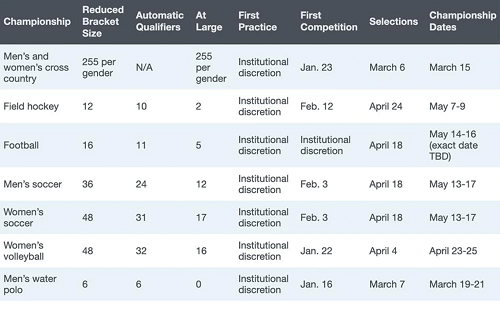
 When the NCAA announced it would postpone fall championships to the spring, it left a number of questions for the event industry. Chief among those was, of course, where championships would be held.
When the NCAA announced it would postpone fall championships to the spring, it left a number of questions for the event industry. Chief among those was, of course, where championships would be held.
It was, after all, a complex question. Would host cities, who had previously been awarded those fall championships for 2020, be given the priority in decision-making when it comes time to figure out who will host in the spring? What if they have already made a commitment to hosting another event at that time, using those same facilities? If they have to turn that event away, will they automatically be granted the championship in a future cycle, or will their inability to host not sit well with the decision-makers of NCAA?
When SDM first reported on this issue in late August, NCAA did not yet have the answers. Even more perplexing was the fact that NCAA referred to “scaled-back championships.”
At this point, some answers are available. Brackets sizes will be filled at 75 percent of their normal capacities.
All championship sites will be predetermined, and the number of preliminary-round sites will be reduced to support health and safety.
“The plan sent to us by the Division I Council provides the maximum number of opportunities to fall student-athletes to participate in NCAA championships while still being fiscally responsible,” said acting board chair Denise Trauth, president at Texas State. “We look forward to the spring, understanding things will look a little different but knowing the competitions will be just as meaningful as in normal circumstances.”
So when can we expect to hear the locations for the reconfigured season championships? Soon, says Russ Yurk, the leader of the host bid process.
“We’re close,” Yurk says. “Most of the postponed DI championship final sites are set. There are a couple that need to find new locations due to the host being unavailable or the local/state regulations preventing teams from traveling in without a mandatory quarantine.”
Ultimately, he adds, “We’re hoping to announce the changes to the preliminary rounds for those fall and many winter championships by end of November. No formal date for the final site announcement has been made.”
So what’s at stake? Here’s a review. All the way back in the spring of 2017, NCAA awarded championships; fall sports for 2020 are detailed below:
- Women’s Field Hockey Championship, Old Dominion University (LR Hill Sports Complex), Norfolk, Virginia – originally scheduled for November 2020
- Men’s Soccer College Cup, UC Santa Barbara (Meredith Field at Harder Stadium), Santa Barbara, California – originally scheduled for December 2020
- Women’s Soccer College Cup, Campbell and Town of Cary, North Carolina (WakeMed Soccer Park) – originally scheduled for December 2020
- Women’s Volleyball Championship, Omaha, Nebraska and Metropolitan Entertainment (CHI Health Center Omaha) – originally scheduled for December 2020
- Men’s and Women’s Cross Country Cross Country Championships: Oklahoma State (OSU Cross Country Course), Stillwater, Oklahoma – originally scheduled for November 2020 (Multiple regionals were also awarded; information on these can be found here).
- Men’s Water Polo Championships (listed separately from the above four sports): Stanford University (Avery Aquatic Center) – originally scheduled for December 2020
- The College Football Playoffs National Championship, also announced separately from the above events, is currently scheduled for the Hard Rock Stadium in Miami Gardens, Florida, on January 11, 2021. Note: NCAA has noted that the Division I Competition Oversight Committee and Division I Football Oversight Committee will continue to work on more detailed models for fall championships in the impacted sports, with the priority of preserving opportunities for winter and spring student-athletes who did not have the chance to participate in NCAA championships in 2019-20.
The NCAA's DII and DIII championships for fall have already been cancelled so if the organization's DI fall championships can be presented successfully in the spring, they will follow the lead of NAIA in representing a strong comeback for college sports as a whole – and both organizations will help send the message that sports hosting cities are open for business and ready to bid on future events.
SDM will continue to follow this developing issue, and to report on location announcements.

